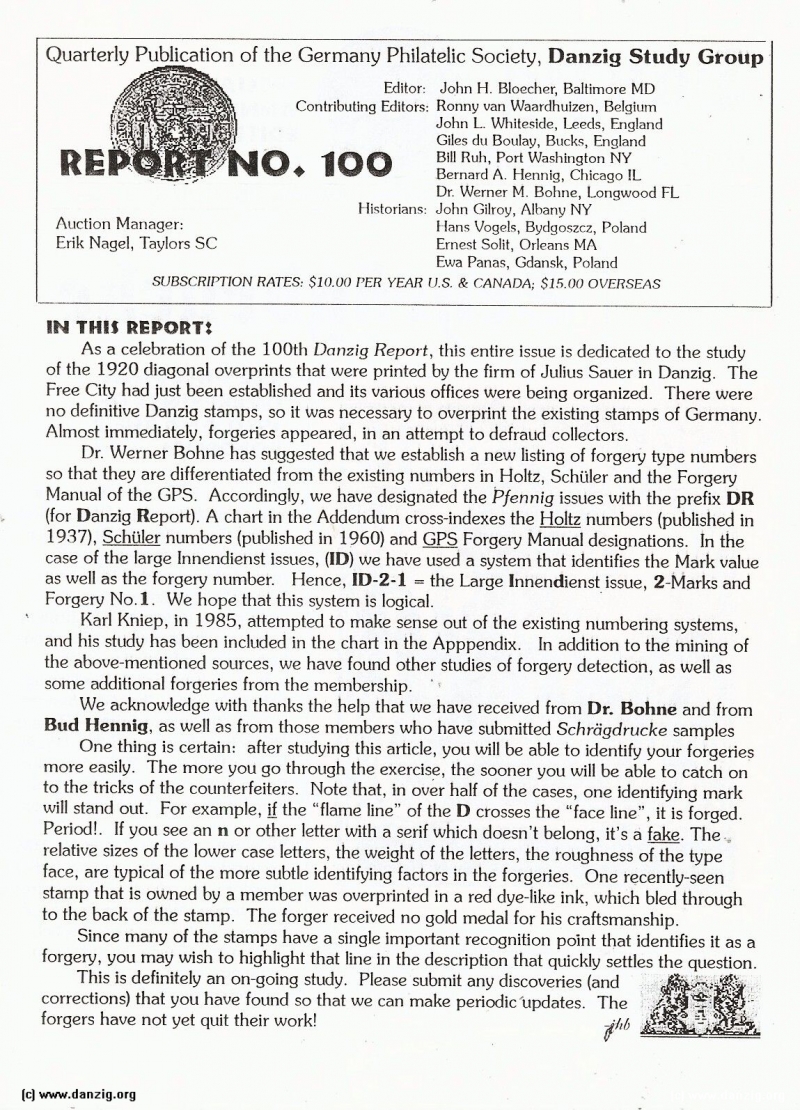
IN THIS REPORT
As a celebration of the 100th Danzig Report, this entire issue is dedicated to the study of the 1920 diagonal overprints that were printed by the firm of Julius Sauer in Danzig. The Free City had just been established and its various offices were being organized. There were no definitive Danzig stamps, so it was necessary to overprint the existing stamps of Germany. Almost immediately, forgeries appeared, in an attempt to defraud collectors.
Dr. Werner Bohne has suggested that we establish a new listing of forgery type numbers so that they are differentiated from the existing numbers in Holtz, Schüler and the Forgery Manual of the GPS. Accordingly, we have designated the Pfennig issues with the prefix DR (for Danzig Report). A chart in the Addendum cross-indexes the Holtz numbers (published in 1937), Schüler numbers (published in 1960) and GPS Forgery Manual designations. In the case of the large lnnendienst issues, (ID) we have used a system that identifies the Mark value as well as the forgery number. Hence, ID-2-1 = the Large Innendienst issue, 2-Marks and Forgery No. 1. We hope that this system is logical.
Karl Kniep, in 1985, attempted to make sense out of the existing numbering systems, and his study has been included in the chart in the Apppendix. In addition to the mining of the above-mentioned sources, we have found other studies of forgery detection, as well as some additional forgeries from the membership.
We acknowledge with thanks the help that we have received from Dr. Bohne and from Bud Hennig, as well as from those members who have submitted Schrägdrucke samples.
One thing is certain: after studying this article, you will be able to identify your forgeries more easily. The more you go through the exercise, the sooner you will be able to catch on to the tricks of the counterfeiters. Note that, in over half of the cases, one identifying mark will stand out. For example, if the “flame line” of the D crosses the “face line”, it is forged. Period!. If you see an n or other letter with a serif which doesn’t belong, it’s a fake. The relative sizes of the lower case letters, the weight of the letters, the roughness of the type face, are typical of the more subtle identifying factors in the forgeries. One recently seen stamp that is owned by a member was overprinted in a red dye-like ink, which bled through to the back of the stamp. The forger received no gold medal for his craftsmanship.
Since many of the stamps have a single important recognition point that identifies it as a forgery, you may wish to highlight that line in the description that quickly settles the question.
This is definitely an on-going study. Please submit any discoveries (and corrections) that you have found so that we can make periodic updates. The forgers have not yet quit their work!
Danzig Report Nr. 100 - July - August - September - 1998, Page 2.
Hits: 3882
Added: 22/07/2015
Copyright: 2025 Danzig.org

